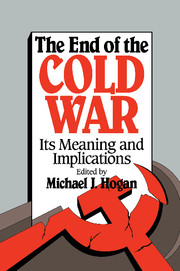Book contents
- Frontmatter
- Contents
- Preface
- The Authors
- Dedication
- 1 Introduction
- 2 An End to Which Cold War?
- 3 The Cold War, the Long Peace, and the Future
- 4 Quiet Cataclysm: Some Afterthoughts on World War III
- 5 Some Lessons from the Cold War
- 6 Nuclear Weapons and European Security during the Cold War
- 7 Victory in the Postwar Era: Despite the Cold War or Because of It?
- 8 The Wicked Witch of the West is Dead. Long Live the Wicked Witch of the East
- 9 The End and the Begining
- 10 A Balance Sheet: Lippmann, Kennan, and the Cold War
- 11 Why Did the Cold War Arise, and Why Did It End?
- 12 A View from Below
- 13 The End of the Cold War and the Middle East
- 14 The End of the Cold War in the Near East: What It Means for Historians and Policy Planners
- 15 After the Cold War: The United States, Germany, and European Security
- 16 The End of the Cold War: A Skeptical View
- 17 The End of the Cold War, the New Role for Europe, and the Decline of the United States
- 18 The Fading of the Cold War—and the Demystification of Twentieth-Century Issues
- 19 The U.S. Government, a Legacy of the Cold War
- 20 Foreign Policy, Partisan Politics, and the End of the Cold War
- 21 Beyond Bipolarity in Space and Time
- 22 A Usable Past for the Future
- Selective Bibliography
- Index
1 - Introduction
Published online by Cambridge University Press: 18 December 2009
- Frontmatter
- Contents
- Preface
- The Authors
- Dedication
- 1 Introduction
- 2 An End to Which Cold War?
- 3 The Cold War, the Long Peace, and the Future
- 4 Quiet Cataclysm: Some Afterthoughts on World War III
- 5 Some Lessons from the Cold War
- 6 Nuclear Weapons and European Security during the Cold War
- 7 Victory in the Postwar Era: Despite the Cold War or Because of It?
- 8 The Wicked Witch of the West is Dead. Long Live the Wicked Witch of the East
- 9 The End and the Begining
- 10 A Balance Sheet: Lippmann, Kennan, and the Cold War
- 11 Why Did the Cold War Arise, and Why Did It End?
- 12 A View from Below
- 13 The End of the Cold War and the Middle East
- 14 The End of the Cold War in the Near East: What It Means for Historians and Policy Planners
- 15 After the Cold War: The United States, Germany, and European Security
- 16 The End of the Cold War: A Skeptical View
- 17 The End of the Cold War, the New Role for Europe, and the Decline of the United States
- 18 The Fading of the Cold War—and the Demystification of Twentieth-Century Issues
- 19 The U.S. Government, a Legacy of the Cold War
- 20 Foreign Policy, Partisan Politics, and the End of the Cold War
- 21 Beyond Bipolarity in Space and Time
- 22 A Usable Past for the Future
- Selective Bibliography
- Index
Summary
The destruction of the Berlin Wall in late 1989 marked, in a symbolic way, the beginning of the end of the Cold War, at least insofar as that era in modern history is defined as an ideological and geopolitical struggle between the Soviet Union and the United States, between Russia and the West. That great event, which set the stage for the reunification of Germany and the end of the Soviet empire in Eastern Europe, had earlier been preceded by the reforms of glasnost and perestroika that Premier Mikhail S. Gorbachev had begun to engineer in the Soviet Union. Taken together, these astonishing developments became a cause for great celebration, especially in Europe and the United States. But history happens quickly these days. What most would consider the news of a lifetime now travels from the headlines to the backpage before we can fully appreciate its significance.
After the events of 1989, the focus of media attention and public policy shifted dramatically to developments in the Middle East, notably the Gulf war, to the demise of the Soviet Union, and to the “New World” that President George Bush and others hope to build on the ashes of the old order. There has not been a lot of time for careful reflection on what the end of the Cold War means to governments and people around the world. To be sure, editorial writers continue to fill the press with commentary on different aspects of the subject, much of it very incisive.
- Type
- Chapter
- Information
- The End of the Cold WarIts Meaning and Implications, pp. 1 - 12Publisher: Cambridge University PressPrint publication year: 1992



